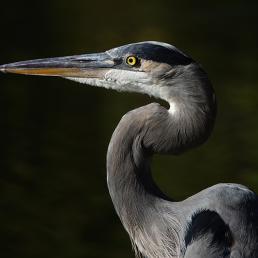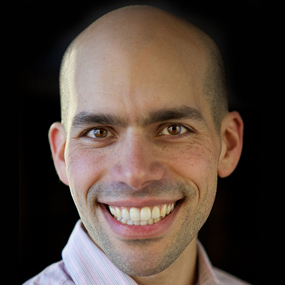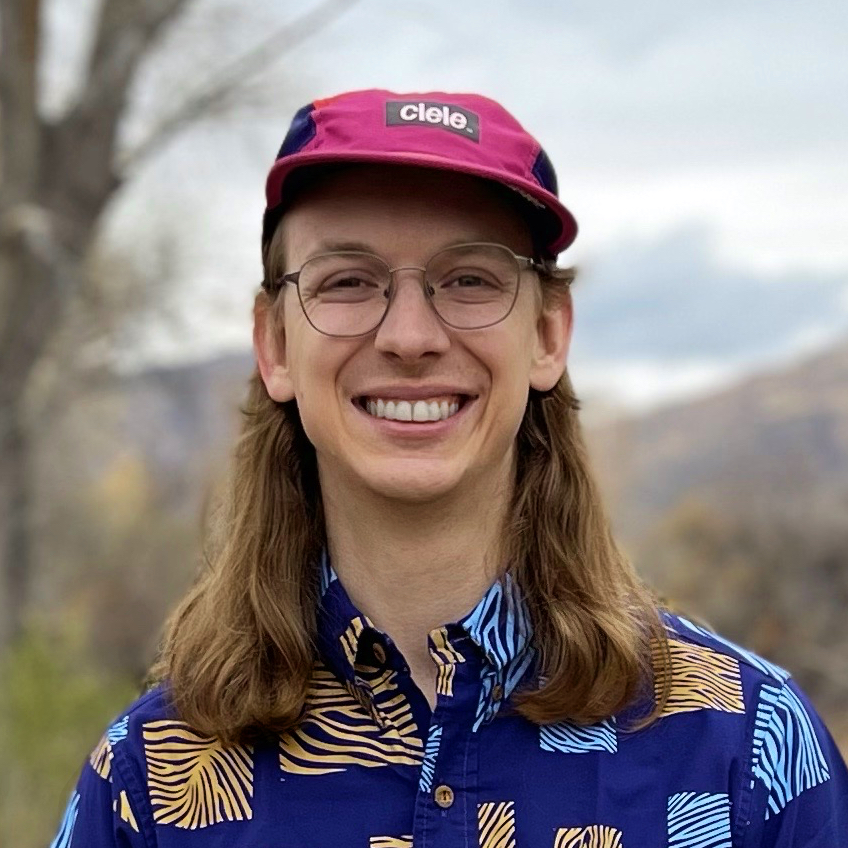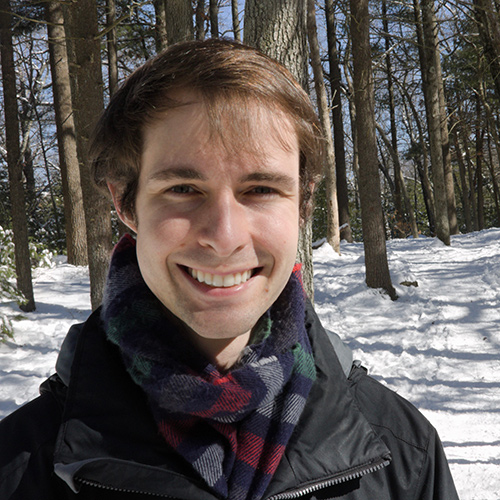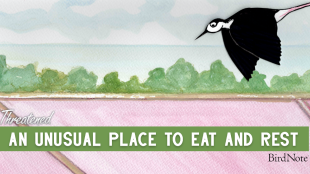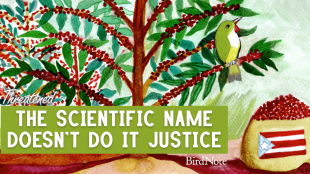

Join BirdNote tomorrow, November 30th!
Illustrator David Sibley and actor H. Jon Benjamin will face off in the bird illustration battle of the century during BirdNote's Year-end Celebration and Auction!
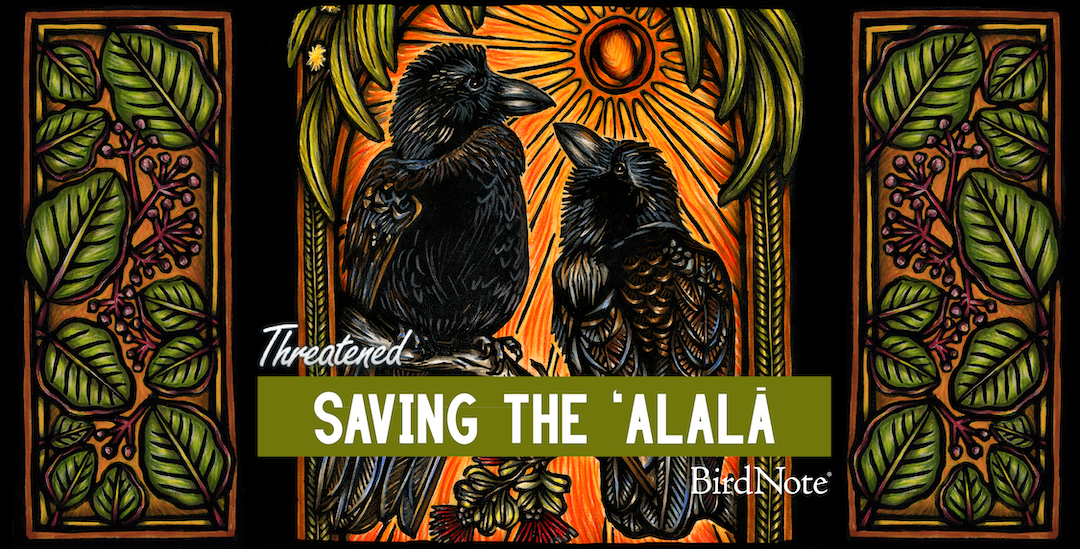
Hawai‘i has its own species of crow, the clever and charismatic ʻAlalā. But the species hasn’t been able to survive in its shrinking native habitat. The only reason the ʻAlalā still exists is because of captive breeding programs. Reintroducing them to the wild is fraught with challenges, but it’s needed for the continuation of the species and for the health of the forest itself.
Ari Daniel: BirdNote Presents.
[Echoing Wingflaps SFX]
[Reflective Threatened theme music begins]
Ari Daniel: What do we do when we’ve already screwed things up? It’s the same old heartbreak in conservation: first comes habitat loss, and then… extinction. But there is a middle ground – a different destination, a kind of tenuous stop gap. You know you're in that “in between” place when you hear words like captive breeding, reintroduction, path to recovery. But can a species raised in captivity ever fully thrive again in the wild? And what is being lost in the process?
[ʻAlalā vocalizations; it’s a nasal sounding bird, like other crows and corvids]
Ari Daniel: Enter the story of the Hawaiian crow, the ‘Alalā. Producer and field biologist Jessie Eden is here to help us answer some of these tangled questions. Welcome back Jessie.
Jessie Eden: Hey! Thanks Ari, good to be back!
Ari Daniel: Why don’t you start off by telling us about this bird, the ‘Alalā?
Jessie Eden: Sure. Well the ‘Alalā are found nowhere else in the world but here in Hawaii. This Hawaiian crow, a member of the Corvid family of birds, used to thrive in big territories, nesting and foraging along the southern regions of Hawaii Island. They are ecologically and culturally important – ‘Alalā evolved mutually beneficial relationships with the plants and trees in their native Big Island forests. And, for many Native Hawaiians, ‘Alalā are revered as an ‘aumakua species, a spiritual family and forest guardian.
But the forest has gone through many changes over the years — and the ‘Alalā have found themselves in a bit of trouble. Paul Banko is a wildlife biologist who studied ‘Alalā in the early years.
Paul Banko: By the 1990s, the wild population had shrunk to about 12 birds.
Ari Daniel: Wow. Just 12 birds? I Can't believe that.
Jessie Eden: Yeah, pretty desperate times for sure. Forest ecosystems in Hawaii have been fragmented and damaged. And so the ‘Alalā, like other native birds, have suffered right alongside their forests.
Biologists and conservation experts wrestled with what to do.
Paul Banko: The plan was devised to take drastic action because the population was just about winking out.
Ari Daniel: Drastic action. What does that mean in this case?
Jessie Eden: Well, here it meant establishing a captive breeding program before the birds went extinct in the wild. And then, when there were enough, they’d start to release them back into the forests.
[Gentle, curious, hopeful synth music begins]
Jessie Eden: But there’s a lot going on in between to make sure the ‘Alalā born in captivity are ready to one day return to the forest.
Sarah Malick-Wahls: So birds that have been hatched and raised in captivity are not exposed to the same stimuli as they are in the wild.
Jessie Eden: Sarah Malick-Wahls is the ‘Alalā Research and Recovery Coordinator with the Maui Forest Bird Recovery Project.
Sarah Malick-Wahls: They have to develop complex foraging skills that really can only be obtained through interaction with the environment in the wild.
Jessie Eden: And Donna Ball is a deputy refuge manager and one of the biologists who studied ‘Alalā in the wild.
Donna Ball: I have so many memories of, like, the birds sitting on the nest, the female incubating and the male coming in and feeding her. And just to watch through a spotting scope, you know, him push purple berries with his tongue, one by one, like a pinball machine into her mouth.
[Sounds of a 1970s pinball machine Quick Draw dinging repeatedly]
They would pick like clusters of them, fly off with a cluster of them, land perch, and put their foot on the cluster and just pick away– like our equivalent would be us sitting down with a handful of grapes.
[More pinball sounds of the score counter clicking higher]
Jessie Eden: ‘Alalā used to eat over 30 different types of wild fruits. Over the generations, they learned to take advantage of the seasonal foods ripening up and down the elevations – and they spread those seeds throughout the forest, helping it to regenerate.
[Gentle music fades out]
Jessie Eden: But how do you teach captive birds these kinds of behaviors? How do you even attempt to recreate something as complex as this ecosystem they used to be a part of?
There’s also a social structure for wild bird populations that’s hard to replicate – different relationships and family dynamics… Here's Paul again.
Paul Banko: They have a very strong sense of place, like many people do — and a very strong commitment to family and just the day-to-day necessities of watching your partner's back.
Jessie Eden: Sarah and her colleagues are doing their best to foster that natural ‘Alalā behavior and learning in captivity.
Sarah Malick-Wahls:There's a socialization process that we're using at the breeding centers, where birds are put into juvenile flocks to try to develop proper communication skills and, and other things that you would get that are kind of intangible from interacting with a cohort of your peers.
Jessie Eden: A large part of this is ‘Alalā vocalizations. Each one is associated with a particular behavior like territoriality and family connections. But ‘Alalā have to learn language from each other; they’re not born with all of this knowledge. So the research that Donna has done toward ‘Alalā communication and behavior has been invaluable to the efforts to re-wild these birds. And Donna’s really adept at interpreting ‘Alalā calls:
[‘Alalā vocalizations, higher pitched and with less control]
Donna Ball: Practice calls.
Jessie Eden: Okay. So they're just messing around?
Donna Ball: They're messing around, they're developing their repertoire. The juvenile birds can play with their vocalizations for a few years, sometimes before they get the full adult expression of calls.
Jessie Eden: Huh.
Donna Ball: Yeah.
[‘Alalā vocalizations, standard]
Donna Ball: That's an adult call.
[‘Alalā vocalizations, lower pitched and more forceful sounding]
Donna Ball: Adult scolding calls. Definitely an adult scolding call.
[‘Alalā vocalizations, sounding like a crying child]
Donna Ball: That's a baby. “Wahhh!”
Jessie Eden: That last one?
Donna Ball: Oh yeah.
Ari Daniel: Wow. It’s remarkable to hear all those different kinds of calls, Jessie. And it reminds me of the cultural transmission that we have in people. How we teach our children about how to behave, how to speak. And it seems like it’s the same with these crows. That they’re learning from their peers and other adults, how to vocalize and how to behave.
Jessie Eden: Yeah. Absolutely. It is exactly the same process.
Ari Daniel: But I have to imagine that in captivity, replicating that process would be somewhat challenging.
Jessie Eden: Yeah, this effort to rewild these birds back into their native forests was always going to be challenging. So, here we are, already struggling to figure out how to raise forest savvy birds in a captive setting.
But let’s add another layer of difficulty, shall we?
Ari Daniel: Do we have to?
Jessie Eden: [laughs] Unfortunately.
[Bouncy, slightly tense, curious synth music begins]
Jessie Eden: The ‘Alalā has a natural predator in the forest - the ‘Io, the Hawaiian Hawk. The ‘Io lives here on Hawaii Island.
And this Hawaiian hawk? It eats crow — literally.
The team tried anti-predator training with the ‘Alalā — to teach these captive birds about the ‘Io and to avoid them.
Like, they played specific recorded ‘Alalā calls when a hawk was visible. The team had learned how to do this from conservation experts in Puerto Rico.
Donna Ball:They had a surrogate in Puerto Rico, that they were able to sort of set up in a viewable situation as being an attacked bird. And the Puerto Rican parrots all got to observe it. So it was a very realistic scenario of actual attacks. So, what we tried to do with the ‘Alalā is something similar, but we didn't have a surrogate ‘Alalā to use. So it wasn't as compelling a lesson for the ‘Alalā.
Ari Daniel: We’re going to take a quick break and when we come back - what happens when the ‘Alalā are reintroduced to the wild. Stick around.
[Synth music fades out]
[MIDROLL AD BREAK]
Ari Daniel: So for 20 years, the ‘Alalā, these birds have been living and breeding in captivity. And Jessie, it sounds like there are people who are really committed to giving them what they need to survive and thrive in those conditions. But the goal is to get them back out into the wild. So have they tried that?
Jessie Eden: they have – most recently in 2016.
Rachel Kingsley leads outreach and education for the ‘Alalā Project.
Rachel Kingsley: The conservation breeding population actually reached over a hundred individuals. And so the partnership really felt comfortable with trying to get these birds back out into the wild where they really belong.
Jessie Eden: But it’s not just as simple as opening the conservation center doors and letting the birds fly free.
First, the birds get to level up in a flight-conditioning aviary near the forest release site. It’s a bigger aviary specially designed to get birds ready to be released back into the wild, where they can get used to stretching their wings. And then, once outside…
Rachel Kingsley: Our crew was also out there providing supplemental food for the birds.
Jessie Eden: Supplemental food is one of the few support tools used to help reintroduced birds adjust to their new life in the wild—
Rachel Kingsley: Helping them kind of transition from being fed on a completely daily basis to then having to transition to foraging on their own.
Jessie Eden: And then the team prepared for some intensive monitoring of the birds.
Rachel Kingsley:So each bird was outfitted with a radio transmitter that was attached to a harness. So they wore it kind of like a little backpack.
That allowed us to be able to track the birds on a daily basis. We were trying to find out as much information as we possibly could about where the birds were going, what plants they were interacting with, all of that kind of stuff.
Jessie Eden: With the excitement of this rewilding effort, community outreach stepped up.
[Optimistic keyboard music begins]
Rachel Kingsley: There was a big public event, you know, kind of celebrating these milestones of getting to this part in the whole story of ‘Alalā.
Jessie Eden: The birds were even given names by local elementary school students.
Ari Daniel: Oh that’s lovely, Jessie.
Jessie Eden: Yeah, just so sweet. The students had studied ‘Alalā behavior and biology in class, and they came up with Hawaiian names for some of the birds — like Mele, meaning song or chant, and ‘Alohi, meaning to shine or sparkle.
[Sounds of the Pu‘u Maka‘ala forest where the the ‘Alalā were released; branches rustling, chirps from birds in the background]
And then, the day came… after all these years in captivity, ‘Alalā were released… The first group in 2016. And over the next three years, there were three more releases— 27 birds in total.
Rachel Kingsley: Going out to the forest the first time and hearing their call or seeing them fly free. It was just mesmerizing. It was definitely, it felt right. Like this is how the forest should feel or how it should sound. And it just kind of changed the whole forest.
Jessie Eden: Rachel and crew spent countless hours tracking the ‘Alalā through the forest, learning about their interactions, the places they were exploring, what they were eating.
[Optimistic music has faded out]
Rachel Kingsley: I remember a couple of times, ʻōhiʻa were blooming and I looked down and it was just this trail of ʻōhiʻa blossoms.
And I was like, well, what happened here?
Jessie Eden: ‘Ōhi‘a trees are the backbone of most forests here in Hawaii — and they have these really stunning blossoms - little pompom bunches of stamens, typically a bright red.
Rachel Kingsley: The ‘Alalā will actually pluck the flowers and they'll kind of crush them and then they play with them for a little bit and then drop them. So you could kind of see this whole trail of where these birds were going. And it was like following the little, you know, cracker crumbs kind of thing, to be able to figure out where the birds had gone just by seeing the ʻōhiʻa blossoms, um, on the ground.
Jessie Eden: One day, she was looking for a female ‘Alalā whose signal was showing up right nearby..
Rachel Kingsley: I knew she had to be close. And so just kind of walking in circles forever, it felt like, you know, just around and around and around. And finally, I was just like, you know what? I give up. Like, sit down and have a water break.
Then I hear her, like, scratch her head feathers and her bands clinked together. And sure enough, she was right above me watching me the entire time.
So it was just like she didn't want to be found. They're quite big characters and they have big personalities.
Ari Daniel: So Jessie, they introduced these 27 ‘Alalā back into the wild. And then how did they end up doing?
Jessie Eden: Well, at the start, things really did seem promising.
Rachel Kingsley: We had birds that paired up. They built nests for the first time in 20 years. We believe that the female sat for an entire incubation time, the male was going up and helping provide food and guarding the territory.
Other things that we learned and saw were really positive foraging behaviors. We were watching the birds learn to do things that we had never seen in the conservation breeding facility.
Jessie Eden: The ‘Alalā were doing pretty well for a while. But then, the team started to lose birds.
[Curious, slightly dark music “Bauxite” by Blue Dot Sessions]
Rachel Kingsley: We would get a certain signal with the radio transmitter that they weren't moving. Um, so that would kind of trigger a red alarm for us. So our crew was going out knowing that they were probably searching for a body versus a live bird.
Ari Daniel: What was going on?
Jessie Eden: Well, some deaths the team understood, and some remained mysteries. A few ‘Alalā simply didn’t fare well out there – in spite of the supplemental feeding, poor body condition was one of the diagnoses.
Ari Daniel: Like they starved to death?
Jessie Eden: Yeah, and another effort that didn’t work was that predator aversion training. Sometimes the monitoring team would find ‘Alalā bodies with the telltale signs of an ‘io attack. All of this complicated by the fact that, up until recently, the ‘io was listed as endangered…
Rachel Kingsley: You know, you have another threatened/endangered species eating an endangered species. So there's not much we could do…
[Curious music fades out]
Donna Ball: the ‘Alalā and the ‘Io, they evolved together
Jessie Eden: Here’s Donna again.
Donna Ball: and I think in a properly operating ecosystem that may not be. uh, an issue, but when the system is so fragmented – and all of these introduced prey have been inserted into the scenario, rodents and game birds and losing the understory – it just gave the ‘Io an edge
Jessie Eden: The understory in these forests consists of smaller trees and shrubs below the canopy. The loss of this tree cover made it easier for the ‘Io to see potential prey…
Donna Ball: It was beneficial to them. It made hunting easy - and the ‘Alalā, they're going to seek cover. If they're pursued by an avian predator, you know, if there's no cover, then they're going to be at a disadvantage.
Ari Daniel: Oh my goodness. I mean, everything's just so tenuous, you know, everything's on the edge here. I mean an ecosystem is this interconnected web. You know, this conservation effort of the ‘Alalā that you're mentioning. It's focused on a single species, but that species used to sit in concert with all these other dynamics, but everything is just so frayed…. that it sounds like a really difficult kind of regime to rebalance.
Jessie Eden: It is. It's about all the little pieces of resilience and relationship that keep getting damaged. And then you have this cascade of loss.
Sarah Malick-Wahls: Mortalities kind of ramped up in late 2019. And by summer of 2020, we only had five birds remaining.
Ari Daniel: Just 5 birds. The numbers keep falling.
Jessie Eden: Yeah, absolute heartbreak. But as painful as it is, some losses of ‘Alalā were actually expected. The birds are still learning and we’re trying to teach them what we think they need to know – but sometimes that’s just not enough.
Only 5 birds remain out of 27 released to the wild, Ari. What would you do?
Ari Daniel: Bring them back in, I guess.
Jessie Eden: Yep. That’s exactly what the team decided to do…
Sarah Malick-Wahls: The decision was to bring those five that still had some of that wild bird knowledge back into the breeding flock to be able to preserve that knowledge.
Jessie Eden: They brought those 5 ‘Alalā back into captivity. Again.
It’s always tougher than we think. We’ve got to check our hubris at the door - there’s no “we got this!”, you know. Nature is always so much more nuanced and elegant than we can recreate. We humans, we have done a serious number on these fragile island ecosystems, and there’s no easy fix to the problems we’ve caused.
Ari Daniel: So what are they doing, what's the plan?
Jessie Eden: Well, the team actually decided to hit the pause button on reintroduction efforts here. This is Rachel.
Rachel Kingsley: It's just a very complicated relationship that we haven't quite figured out. We don’t know everything about ‘Io, so what we're trying to do is research more information to better understand how we can possibly put ‘Alalā into the habitats where ‘Io exists.
Jessie Eden: And, in the meantime, they’re exploring the potential to reintroduce ‘Alalā into areas without the ‘Io. And luckily, the ‘io only lives on Hawaii Island. So they’re looking to other islands— particularly Maui and the smaller islands that surround it, known as Maui Nui. Here's Sarah.
Sarah Malick-Wahls: We want to learn more about the ‘io. And we understand that the birds either ‘Alalā or a very similar Corvid were in Maui Nui previously, and the forest could really benefit from having them back. So that's why we are now thinking about this next step.
Jessie Eden: Everyone’s continuing to work hard so flocks of ‘Alalā can thrive again in their native forests. Here's Donna.
Donna Ball: We can't fix 200 years of habitat loss and degradation in 30. But we can do our best, you know, trying to focus on the species that we can still help. And I think ‘Alalā still has a chance of, you know, some recovery potential, and maybe they'll get back to the island of Hawaii in the future. And just trying to learn with each effort so that they'll still be with us in a hundred years – beyond our lifetimes, hopefully.
[Reflective Threatened theme music fades in]
Jessie Eden: And, if all goes well, eventually ‘Alalā will find their way back home. Again.
[Reflective Threatened theme music solo]
Ari Daniel: The future for ‘Alalā is still uncertain, but in our next episode we look at conservation efforts that have beenworking for a secretive little seabird called the Ua‘u.
Bret: This is where I'm happiest, with these birds. And I sleep so much better when I know that my ‘Ua’u is safe and its burrow.
Ari Daniel: That’s next week on our Hawai‘i season finale.
This episode was produced by Jessie Eden and me, Ari Daniel. It was edited by Caitlin Pierce of the Rough Cut Collective. Audio mix by Sam Johnson and Mark Bramhill. Fact-checking by Conor Gearin. Our theme song and original music were composed by Ian Coss, with additional music by Blue Dot Sessions. Threatened is a production of BirdNote and overseen by Content Director Allison Wilson. You can find a transcript of this show and additional resources, BirdNote’s other podcasts, and much more at BirdNote dot org. Thanks for listening, and see you next time.
[Threatened theme ends]
######################
SFX:
Bird sounds provided by The Macaulay Library of Natural Sounds at the Cornell Lab of Ornithology, Ithaca, New York. ML218670 Hawaiian Crow recorded by Tim Burr.
‘Alalā vocalization recordings provided by Patrick Hart and the Listening Observatory for Hawaiian Ecosystems (LOHE) Lab at the University of Hawai‘i at Hilo.
XC124707 - Hawaiian Hawk recording by Brooks Rownd provided by Xeno-Canto.
“Classic Pinball Gameplay” by user theshaggyfreak on Freesound.org
MUSIC:
Threatened Theme by Ian Coss
“Lacaille”, “Leatherbound”, and “Dust Digger” by Blue Dot Sessions
